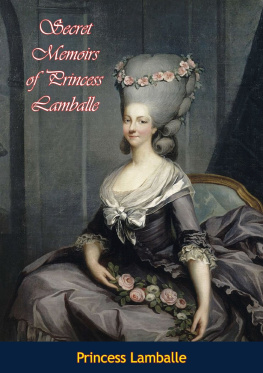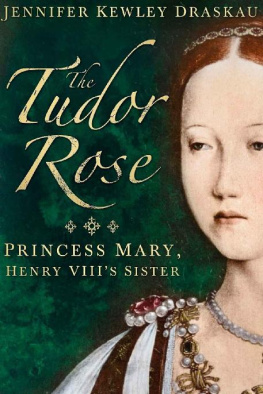
The Kaisers Confidante
Mary Lee, the First American-Born Princess
RICHARD JAY HUTTO

McFarland & Company, Inc., Publishers
Jefferson, North Carolina
e-ISBN: 978-1-4766-2808-0
LIBRARY OF CONGRESS CATALOGUING DATA ARE AVAILABLE
BRITISH LIBRARY CATALOGUING DATA ARE AVAILABLE
2017 Richard Jay Hutto. All rights reserved
No part of this book may be reproduced or transmitted in any form or by any means, electronic or mechanical, including photocopying or recording, or by any information storage and retrieval system, without permission in writing from the publisher.
Front cover image Von Klarheit zu Klarheit, Grafin Elisabeth Waldersee, 1918
McFarland & Company, Inc., Publishers
Box 611, Jefferson, North Carolina 28640
www.mcfarlandpub.com
For Katy and Martin
Preface
Mary Lee, the first American-born princess, is known primarily, if at all, for her two marriages. At the age of 27, in 1864, she married Prince Friedrich of Schleswig-Holstein-Sonderburg-Augustenburg, who was 64 and a brother of the queen of Denmark and of the Duke of Schleswig-Holstein. Widowed on her extended honeymoon in the Holy Land and left a large fortune to add to her own modest one, Mary then married, in 1874, Count Alfred von Waldersee, who would become chief of the German General Staff (18881891), field marshal (1900), and the commander-in-chief of the Eight-Nation Alliance (including the United States) that suppressed Chinas Boxer Rebellion (19001901). The long-coveted chancellorship was often dangled in front of him like a precious jewel but was always pulled from his fingertips at the last moment. His wife was deservedly given much of the credit for his success at court, where she enjoyed a great deal of influence as the mentor and friend of the kaiserin, wife of Wilhelm II. The reach and intensity of that influence is the subject examined here.
In 2008, I included Mary von Waldersee in my book Crowning Glory: American Wives of Princes and Dukes. Her entry was only three pages long, but the memory of her remained with me. It seemed inconceivable that a woman of her supposed influence at the German courtshe continued to be listed in the authoritative Almanach de Gotha (the official guide to royal families) as a princess even after her remarriagewould have so little written about her. A year after her death, her husbands niece, Countess Elisabeth von Waldersee, wrote what amounted to a hagiography concentrating upon her religious activities and philanthropy. According to her, Mary did not want her diaries to be made public, and they are presumed to have been destroyed.
In 1962, one of Marys cousins, Alson J. Smith, wrote a rather odd book that made use of the voluminous correspondence of Mary and her mother. Although written as fact, there is more than a little fiction to his work. Not only was Smith very selective in his reliance upon primary sources in the family correspondence, he deliberately ignored or misstated those that did not agree with his opinions (even alleging a sexual relationship between Mary and Kaiser Wilhelm II, for which there is no supporting evidence of any kind). The earlier information he provides about Marys family background is on much firmer ground (his mother was a great-niece of Marys father), and every effort has been made to verify any of his statements relied upon in this work.
Mary von Waldersee strongly disliked publicity and wrote only one article about her life,
Marys second husband, Count Alfred von Waldersee, faithfully kept a diary for decades and those have been published in an abridged version in English
The treasure trove of information, however, is in 17 uncatalogued boxes of correspondence and memorabilia in Harvards Houghton Library given, along with a modest bequest for their maintenance, in 1922 by Mary Perkins Quincy (who visited Mary in Hanover in March of 1907), a niece of Mary Hoppin, to whom most of the letters were written. Although arranged roughly (but not wholly) chronologically, they beg for an authoritative and scholarly cataloguing. While quite a few of the letters are written by Mary von Waldersee, the great majority were written by her indefatigable mother, Ann D. Lee, who lived with Mary for most of her adult life until her death at the age of 96. Her frequent letters, usually written to her cousin in America, Mary Hoppin (whose husband was a professor at Yale), were then circulated among other family members so that everyone would know of her life in Germany. There are also dried flowers from Chancellor Bismarcks private garden, seating charts, calling cards, newspaper clippings, and other memorabilia Mrs. Lee sent with explanatory notes.
When the gift of the collection was announced, the Harvard Alumni Bulletin boasted that the letters had been bound in black German leather, made from the hide of an Indian goat, tanned and finished in Germany. The sides are finished in Japanese hand-made, laid paper, designed and hand-printed in France. The color scheme is the black, red, and white of the old empire, and the Hohenzollern Eagle is used as a design.
Mrs. Lee was a woman of good lineage and fine education who possessed an excellent observers eye for detail and understatement. Unfortunately, she also exhibited the prejudices of her day, strongly disliking Jews as well as Catholics in general and Jesuits in particular. Occasionally, the date of her multi-page letters may be misleading, since Mrs. Lee often started a letter on which she would write the date on the first page only to continue it over the next several days or even weeks before completing and posting it to America.
Mrs. Lee wrote with usual frankness, I have always spoken my opinion freelythat it could only be the devil that leads the Jesuitstheir time of reckoning is sure to come and God will be the avenger. He has not suffered the blood of martyrs to flow like a river without noting it. When she learned that William R. Grace had been elected the first Roman Catholic mayor of New York City, she wrote,
How is it possible our people to the manor born and one would think should feel love of country higher than party, how can they rest in such apathy, yes stupidity and see the R.C. [Roman Catholic] power gaining such sway. It is startling to know what headway they have made. [I]f our country is destroyed it will be by the Papacy. To every reflecting mind it is evident the Pope and the Jesuits are doing their utmost to gain the control of America.
On another instance she wrote, I have charity that sympathizes with all who love Christ Jesus and take His teaching as their standard. But none for the Papacy or Jesuits unless they repent.
In speaking of how the crown prince [Wilhelm II] was viewed in America, she warned, As you knowall the world over Jews have moneywhich is a power in the pressno doubt they send their papers to countrymen in America and thus a false opinion will be formed of the present Crown Princewho in reality has noble qualities.
Mrs. Lees prejudices were not limited to Jews and Catholics, however. When she related the official visit by the Sultan of Morocco, she wrote, The Moors have been here. They were received by their Majesties in Throne Room surrounded by their court. Alfred too was there and also at the Dinner to which Emperor invited thembeing Mahametans [Mohammedans] they were so afraid of eating something prepared with pigsfat they sent their own cook to the Castle to look after their dinner!
Next page











